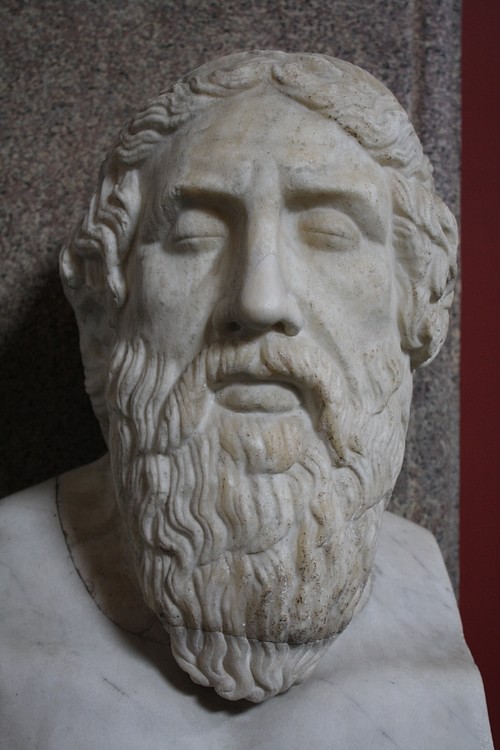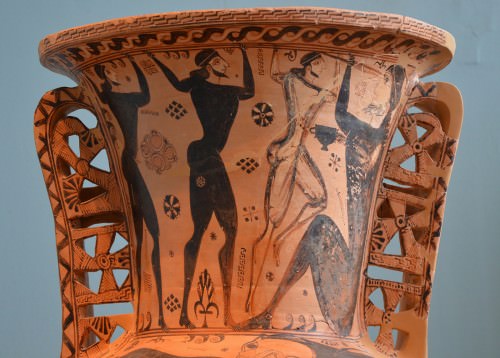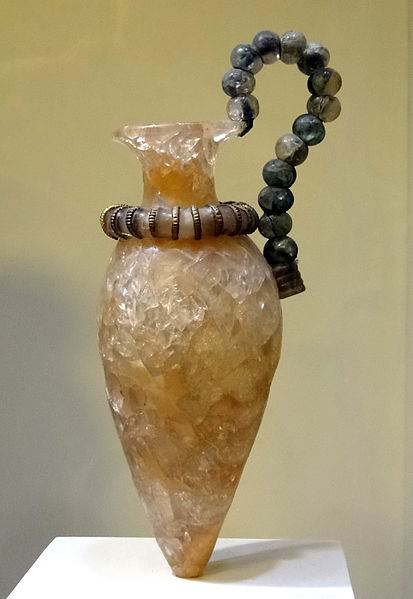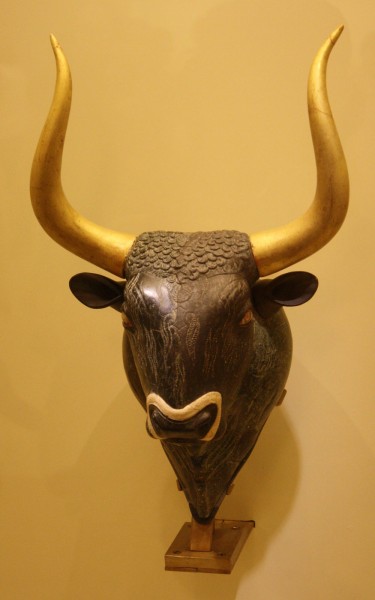Homer › Minoan Stoneware » Ancient origins
Articles and Definitions › Contents
- Homer › Who Was
- Minoan Stoneware › Antique Origins
Ancient civilizations › Historical and archaeological sites
Homer › Who Was
Definition and Origins

Homer (c. 750 BCE) is perhaps the greatest of all epic poets and his legendary status was well established by the time of Classical Athens. He composed (not wrote, since the poems were created and transmitted orally, they were not written down until much later) two major works, the Iliad and the Odyssey ; other works were attributed to Homer, but even in antiquity their authorship was disputed. In conjunction with Hesiod, Homer acts as a great pool of information for the Greeks about their gods. Homer is the earliest poet in Western culture whose works have survived intact.
THE ILIAD
The Iliad is composed of 15,693 hexameters (lines of verse), and is divided into 24 books corresponding to each letter of the Greek alphabet - alpha to omega, a system that was already in place by the time of Herodotus. The Iliad traces the anger of Achilles (“Sing Muse, of the wrath of Achilles” Iliad.1.1) and takes place over 51 days during the tenth and final year of the Trojan War. The poem takes its name from the city of Troy, which is also known as Ilium.
ACHILLES, RESPECT THE GODS AND HAVE PITY ON ME, REMEMBERING YOUR OWN FATHER.
PRIAM TO ACHILLES
PRIAM TO ACHILLES
Highlights include: the lengthy Catalogue of Ships of the Greek invading forces, the death of Patroclus and the description of him being carried away by the twins Hypnos and Thanatos (Sleep and Death), the description of the shield of Achilles, the reconciliation between Achilles and Priam, perhaps one of the most moving scenes in Western literature, and several set-piece battles between pairs of Greek heroes, most famously the fight between Achilles and Hektor. In all of these events the intervention of the Greek gods, especially Athena on the side of the Greeks and Apollo for the Trojans, is instrumental in the outcome of all of the human actions during the war.

The blinding of Polyphemus
THE ODYSSEY
The Odyssey is composed of 12,109 hexameters and is also divided into 24 in the same manner as the Iliad. Whereas war and anger were the themes of the Iliad, the Odyssey takes place after the Trojan War has been won by the Achaeans, as the Greeks are referred to by Homer. The Odyssey is concerned with the nostos (journey) of the Greek hero Odysseus (the protagonist after whom the poem is named) and the troubles that he faces on his way home from Troy, foiled on his way by godly interventions, especially those of Poseidon. Highlights include Odysseus' famous encounters with the Sirens, with the Cyclops Polythemus, and the slaying of his wife Penelope's suitors upon his return to Ithaca.
WE HANDLED OUR POLE WITH ITS RED-HOT POINT AND TWISTED IT IN HIS EYE TILL THE BLOOD BOILED UP ROUND THE BURNING WOOD.
ODYSSEUS ON BLINDING THE CYCLOPS
ODYSSEUS ON BLINDING THE CYCLOPS
Unlike Hesiod, who mentions his family and life within his works, this is not really the case for Homer, and since writing is generally believed to have started around 700 BCE, there is no contemporary source on him either, but there are various later Hellenistic and even Roman descriptions of his life (and also the Contest of Homer and Hesiod). Because the dialect of Homer's works is composed in an archaic form of Ionian Greek and he displays a familiarity with the geography of Asia Minorin the Iliad, there could be some element of truth to claims that Homer's birthplace was Symrna, Chios, or Ios.
A SINGLE HOMER?
There have always been debates as to the 'person' of Homer: many places claim to be his birthplace. It is even debated whether or not the two great works were written by the same person: the ancients called those who thought this the chorizontes ; the separatists. Some even doubt if one single person was behind these works, and that leads to 'the Homeric Question', the idea that the poems are a compilation of layers rolled into one story, which could explain inconsistencies in the narrative and the formulaic language used. According to this school of thought, the poems would most likely have been sung episodically by rhapsodes. This idea was first argued by FA Wolf in his 1795 CE work Prolegomena ad Homerum.
Nevertheless, whether Homer was a 'she', a 'he', or a 'they' does not diminish the greatness of the Iliad and the Odyssey, and this can be seen by the fact that the two poems have come down to us in a continuous tradition. The poems were first compiled, organised, and edited under the Athenian Peisistratus, but the Greek text that we have survives from such Alexandrian scholars as Zenodotus and Aristophanes of Byzantium and Aristarchus and their comments on the texts. The first printed editions of Homer were in 1488 CE in Florence by Chalcondyles of Athens. Homer's work was hugely influential on Greek culture, and scenes from his works appeared in Greek sculpture, on Greek pottery, and in Greek tragedy and comedy. He was studied as part of Greek education, and the legends within his work would influence Hellenistic culture, Roman culture, and far beyond, so that Homer's lasting legacy is that his works are still studied to this day.
Minoan Stoneware › Antique Origins
Ancient Civilizations
Craftsmen of the Minoan civilization centred on the island of Crete produced stone vessels from the early Bronze Age (c. 2500 BCE) using a wide variety of stone types which were laboriously carved out to create vessels of all shapes, sizes and function. The craft continued for a millennium and vessels were of such quality that they found their way to the Greek mainland and islands across the Aegean.

Minoan Rock-Crystal Vase
TECHNIQUES
Stone vases are amongst some of the earliest surviving artefacts from the Minoan civilization with examples from the early Minoan phase between 2500 and 2000 BCE. With origins in the Neolithic period and perhaps influenced in the early stages by Egyptian artists, Cretan artisans used chisels, hammers, saws and blades to work blocks of stone, sometimes also using a harder stone tool. The vessels were finished by grinding with an abrasive such as sand or emery imported from Naxos in the Cyclades. The inside of the vessel was carved out using a copper drill turned with a bow and once again using an abrasive.The drill was hollow and so the residual core of stone was then snapped off and the work finished using a second drill.
MOST DESIGNS WERE COPIED FROM POTTERY SHAPES AND EVEN POTTERY DECORATION SUCH AS THE MARINE STYLE WITH ITS OCTOPUSES AND SHELLS WAS TRANSFERRED TO STONE VESSELS.
A wide variety of stone was used by Minoan craftsmen and included variegated marble, limestone, gypsum and calcite (alabaster), breccia, basalt, obsidian, rock-crystal, steatite (soapstone), schist and serpentine. In addition, design and material were often carefully matched so that elegant forms brought to the fore the natural colour variations of the stone. Most designs seem to have been copied from contemporary pottery shapes and even pottery decoration such as the Marine Style with its octopuses and shells was transferred to stone vessels.
Many fine examples of stoneware were produced across Crete including Knossos, Phaistos, Malia, Mochlos, Palaaikastro, Tylissos, Gournia and Zakros. Indeed, such was the success of Minoan artists that vessels were even exported to the Greek mainland and across the Aegean to islands such as the Cyclades.
SHAPES & DESIGNS
Popular shapes include the 'bird's nest' lidded bowl which tapered significantly at the base and was probably used to store thick oils and ointments. The form was produced over a period of 1000 years throughout Crete from 2500 to 1500 BCE. The same shape of vessel but with simple carved lines on the exterior imitating petals is known as a blossom bowl and enjoyed similar longevity in terms of popularity as the 'bird's nest' variety. The most common material for these vessels was dark grey serpentine, although, one notable lid with a carved dog is made from green schist.

Minoan Stone Vases
As artists grew in confidence other, more ambitious and larger vessels were made such as ritual vases or rhyta which could take many forms. These were usually covered in gold leaf and were especially popular in the 15th century BCE, when the outer surfaces were, once again, often decorated with scenes carved in relief. A typical example is the Chieftain Cup in serpentine which depicts a young prince in Cretan costume, high boots and jewelled collar holding a sceptre and giving orders to one of his captains outside what appears to be a palace. Conical shapes with a single handle were popular but rhyta could also be made in the shape of animals such as lions, bulls (see below) and even shells, for example, the triton shell from Malia, which is decorated with relief scenes of demons and sealife.
Stone vases were perhaps the most common shape of all for Minoan stoneware. Tall, elegant chalices were produced with horizontal ribbing or vertical flutes, sometimes in quatrefoil form. Another type was the two-handled vase, probably imitating metal vessels, a form which is frequently depicted in Minoan frescoes. Plainer, cylindrical vases, spouted jugs and lidded boxes were also produced, as were small vessels with such limited cavities that they could only have functioned as dedicatory grave goods.
With the Mycenaean takeover of Minoan sites in the second half of the 15th century BCE the production of stoneware ceased at all sites except Knossos. Those vessels that were made tended to be larger and more functional in shape and even these died out on Crete by the early 14th century BCE.

Minoan Rhyton
OUTSTANDING EXAMPLES
Perhaps the most famous example of a stone rhyton is the serpentine bull's head from the Little Palace at Knossos (c. 1600-1500 BCE) which is now in the Archaeological Museum of Heraklion. With gilded wooden horns, rock-crystal eyes and a white tridacna shell muzzle the animal is superbly rendered, capturing a life-like pose that would not be equalled in art until Classical Greek sculpture a millennium later. The head is also engraved to depict short curled hairs above the forehead and longer hairs down the cheeks. The horns have been restored (in imitation of a similar vessel from Mycenae ) but one of the eyes is original and was painted behind with a black iris and red pupil. The eyes are also set inside a thin red jasper surround which gives a bloodshot effect making the bull even more realistic and threatening. The vessel was filled from the neck and liquid poured out from a small hole in the muzzle.

Harvester Vase
Another excellent example of a rhyton in stone is the serpentine Harvester Vase of Hagia Triada on Crete (c. 1500-1450 BCE).Once covered in gold leaf, this vessel, of which only the upper portion survives, is covered in relief scenes depicting a sowing festival with no fewer than 27 figures: an aged gentleman in a cloak, a singer with a rattle or sistrum of Egyptian origin, a choir and figures carrying hoes and bags of seed corn in their belts.

Minoan Rock-Crystal Bowl
Two superb rock-crystal examples are the shallow bowl from Mycenae (but attributed to 16th century BCE Minoan Crete) which has an elegant duck's head for a handle and was perhaps originally used for storing cosmetics. The second striking rock-crystal vessel is a jug from Zakros (c. 1450 BCE) and it was also probably used to pour libation liquids in religious ceremonies. It has a separately made collar of rock-crystal with gilded ivory discs which cleverly hides the join between the neck and body. The jar has a handle made of 14 large green beads, also in rock-crystal, strung onto bronze wire. The vessel was discovered shattered into hundreds of small pieces but it has been painstakingly restored to once again win deserved admiration for the skill and artistry of Minoan stoneworkers.
LICENSE:
Article based on information obtained from these sources:with permission from the Website Ancient History Encyclopedia
Content is available under License Creative Commons: Attribution-NonCommercial-ShareAlike 3.0 Unported. CC-BY-NC-SA License